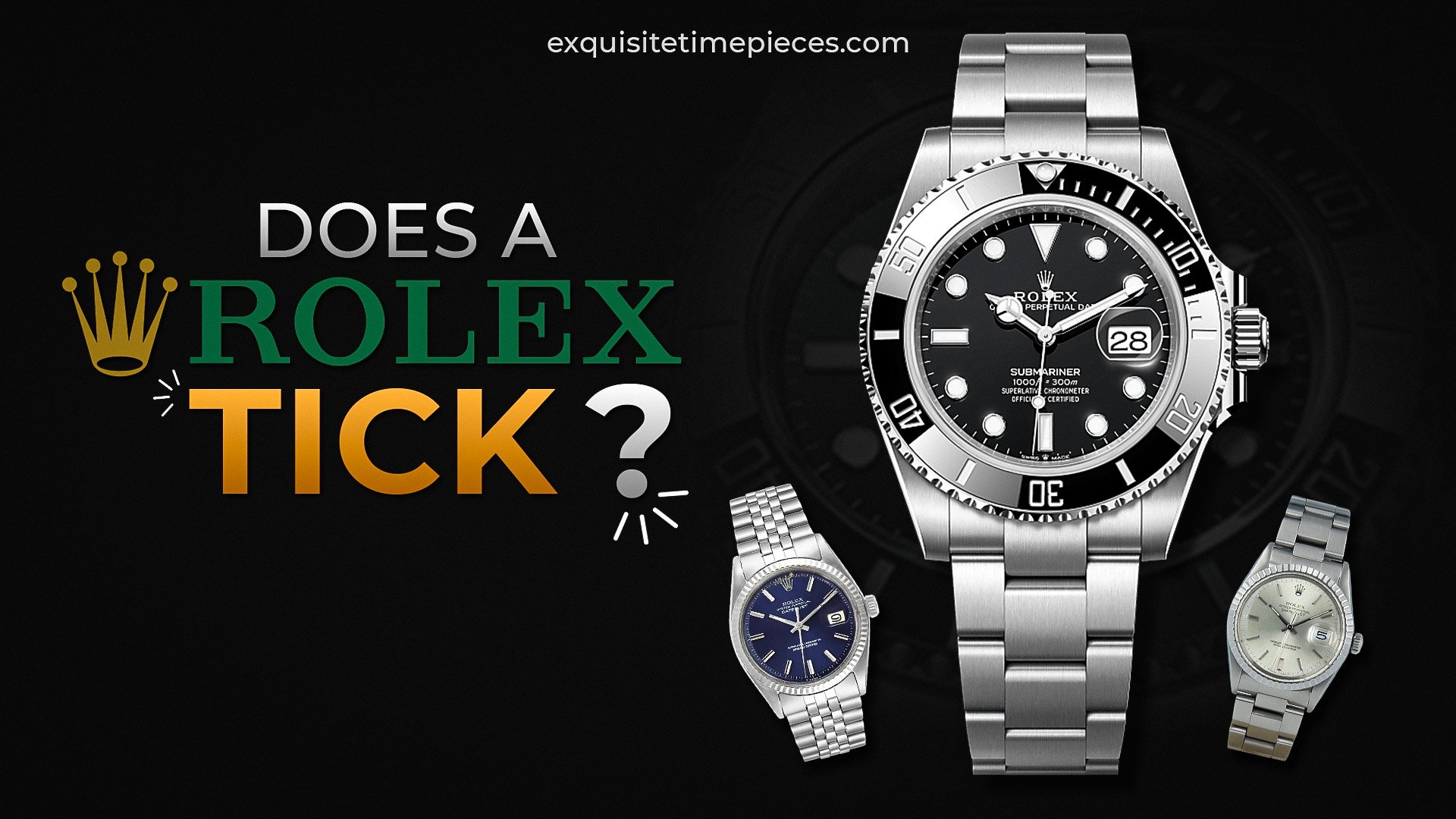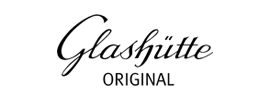
Does A Rolex Tick? The Answer WILL Surprise You!
“Tick-tock, tick-tock, tick-tock”. If you suddenly notice this sound from your Rolex, there are two things involved: you either bought a knock-off model, or you own the classic Oysterquartz. Now, your heart’s pacing. You’re furious, maybe even disappointed; your dealer had the audacity to sell a counterfeit.
Relax. All watches tick. But unlike cheap quartz watches, Rolex watches don’t keep time in the traditional tick-tock fashion. In this article, you’ll learn all about how Rolex watches tick and how the myth they don’t started.
The Origin of the Myth
There’s no denying that many people got into the luxury watch market as a direct result of pop culture. But while I’m not a traditional gatekeeping-type watch enthusiast, I believe you should never let trends influence your taste. You’ll be robbed into splurging and thinking you got a bargain because your favorite artist wore one in a music video.
Meanwhile, you’d have passed on better or comparable affordable options because they’re not trendy. How is this related to the Swiss luxury watch ticking? The myth started when arguably the greatest rapper alive, Jay Z, said, “Rollies that don’t tick-tock”. This braggadocious lyric has been used by countless artists since then, including A-Listers like Lil Durk and Future. It’s true to some extent, but it’s practically impossible for a watch not to “tick-tock.”
What Does It Mean When A Watch Ticks?
The thing about watches is that they all tick. I mean, there’s a sound associated with time itself. You guessed right, “tick-tock tick-tock”. Now why do they make that sound?
To be clear, the volume of a watch’s movement depends on factors like case material, material quality, escapement components, and sometimes, the manufacturer. The general rule of thumb is that timepieces made with cheap, lightweight materials tick the loudest.
But this isn’t always the case; some watches, like models with a pin-lever escapement, generally tick loudly because they use metal instead of jewel pins. And quartz movements are usually quieter than mechanical watches, as they contain fewer or no moving parts.
Anyway, a watch ticks to keep the time running. How it ticks is a direct representation of its internal components/engine/caliber. Or, better yet, its movement. Mechanical watches like Rolex tick faster because they use a complicated mechanical movement rather than quartz, which is a cheaper alternative even though it’s more accurate.
It’s for this reason, and of course, as a status symbol, that many watch enthusiasts remain watch enthusiasts. And Rolex has been on top of the movement engineering game for decades to keep hardcore enthusiasts infatuated and aesthetic buyers drooling.
Let’s talk more about how Rolex and mechanical watches tick differently. More specifically, the reason why A-list rappers believe they don’t tick-tock.
The Sweeping Motion of Rolex and Mechanical Watches
Rolex watches have a second hand that appears to glide through the dial rather than tick-tock. It’s not restricted to the brand, nor is it a novelty. All mechanical watches tick at varying frequencies, including dirt-cheap ones, which are typically faster than quartz. So it gives the illusion that the hand isn’t ticking.
Here’s what goes on behind the dial. A mainspring passes power into an escapement mechanism, which then saves energy by passing it through a couple of gears to the watch hands.
Inside the escapement, a balance wheel swings back and forth like a pendulum, while a pallet fork restricts its movement per second to stay accurate. It’s the speed of this pause-and-start interaction that makes the second-hand in mechanical watches tick in a sweep motion.
Mechanical movement watches with a faster balance wheel keep time more accurately and reliably than slower ones. They usually tick between four, six, and eight times per second, or 21,600, 28,000, or 36,000 bph (beats per hour), respectively.
The only exception is in specialty or vintage watches, like the Antoine Martin Slow Runner 1 Hz, which beats once per second. It took Martin Braun building the largest escapement to achieve this feat in The Slow Runner. But quartz watches achieve this accuracy only at a fraction of the cost of engineering.
Rolex watches tick 8 times a second, 8 hertz, or 28,000 vph (vibrations per hour). Listen to the tick-tock of the Rolex Submariner, played at 0.25 playback speed, below.
Rolex Making the Tick-Tock Sound: A Video
In truth, this is a display of outstanding craftsmanship and engineering. If you listen even closer, you can hear the mechanical tune of the balance wheel and gears grinding to set the wheels of time in motion. But it also shows undeniable evidence that “Rollies tick-tock”. Listen with a headset if you’re still in denial.
Rather than beat on the count of a second, they beat non-stop to make a second and need to be wound when they run out of juice. So this is why Jay Z and the hip hop community consider only a Rolex that “doesn’t tick tock” the symbol of authenticity.
Quartz watches, on the other hand, beat only once, exactly on the second, which is more efficient and accurate. You’ll see why soon. If that’s your situation, it’s true that a “Rolex doesn’t tick”. It’s most likely a knockoff Rolex with a quartz movement.
So if you’re asking if a Rolex jerks per second, the answer is no. Only the Oysterquartz (discontinued in 2001) tick-tocks.
Quartz Watches vs Mechanical Watches
Now we’ve established how Rolex does and doesn’t tick. Here’s why quartz watches beat at a single beat per second. And why they’re better timekeepers than any mechanical watch. It’s quite a simple process.
A quartz crystal is piezoelectric; it can absorb electrical current and convert it into mechanical energy, which powers watch hands. A battery-powered electric circuit sends current to the crystal, which then vibrates 32,768 times in a second.
The circuit monitors these frequencies and pushes the second hand forward on exactly every 32,768th vibration, which creates that one-tick-per-second (tick-tock) motion. In other words, it’s extremely accurate, just like using a smartphone or computer, since it’s programmed on a circuit board.
As you can imagine, this is a cheaper and more reliable system than mechanical movements, which require higher expertise and more materials. Not to mention regular maintenance of the engine. All a quartz watch needs is a battery change and regular cleaning. So it’s no surprise that many watchmakers closed down when quartz watches first hit the market in 1970.
The Rolex Datejust OysterQuartz – the first and only Quartz Rolex
The Rolex Oysterquartz is symbolic of a dark era for the luxury watch market – the Quartz Crisis. While some may see it as proof of desperation from the Swiss watch manufacturer, it’s also evidence of stellar engineering and innovation. Rolex spent five years developing two movements that toppled the quartz movement of the day.
And so, in 1977, they dished out what seemed like a Datejust or Day-Date with a quartz movement. It’s still available today as a collector’s watch. It has the dial of a DateJust but with an angular case, an integrated bracelet, and an over-engineered quartz movement.
Some enthusiasts call this movement a hybrid because it was way ahead of its time. It has 11 jewels, a lever escapement, and can self-regulate for super precision. Nonetheless, the point here is that this is the only Rolex watch that tick-tocks.
Rolex Mechanical Watch Movements
Manual winding watch movements require you to wind the crown when the power reserve runs out (worn or not). Rolex has a handful of them; the majority of their current models carry an automatic movement.
Explore the
Biggest Pre-Owned Collection of Luxury Watches
The most iconic hand-wound Rolex I’ve seen so far is the Rolex Cellini Vintage 1974, ref. 4083. Or Rolex Cellini 50505 in an 18k gold case. There’s no denying that this collection was the brand’s flagship for a taste of elegance and classic dress watches.
Yet it offers exceptional value for the money, as far as high-end luxury dress watches are concerned. It’s now reborn in the Rolex 1908 collection and newer Cellini models with automatic movements. The point here is that Rolex’s mechanical watches tick in a sweeping motion.
Rolex Automatic Movements
The go-to for Rolex luxury watch brands is the self-winding mechanical movement. This kind of movement charges the mainspring for as long as you wear the watch. Using kinetic energy, a rotor behind a case back swings in rhythm with your wrist movement, automatically coiling the mainspring. When unused, it keeps time until the power reserve is depleted.
Current versions of Rolex’s automatic movements beat at 28,800 vibrations per hour (vph). Alternatively, 8 ticks per second would facilitate the highest level of precision and reliability. Although we’ve seen varying frequencies over the years, Rolex has never produced a movement with a single beat per second. One thing Jay Z was right about, though, was when he said: “Audemars, that’s losing time”.
Debunking The Myth: “Rolex Watches Don’t Tick”
I hope this article comprehensively and adequately answers the question, “Does a Rolex tick?” for anyone curious. Surely, with this clarity, you understand why giving a straight answer is hard because the question can come from different viewpoints.
If you’re a fan of rap and have heard the infamous Jay-Z line, he’s fundamentally wrong about Rollies that don’t tick-tock. The second-hand ticks voraciously fast, so it appears as if it’s sweeping the dial. In Jiggaman’s defense, though, it was a sick rhyme to the previous line. Maybe J. Hova meant to say they don’t tick, but they sweep.
However, if you’re a curious watch owner, then you’re right to be anxious; a Rolex never ticks. Only the vintage Oysterquartz tick-tocks every second. An authentic Rolex watch should “tick-tocks” 8 times per second.
About Exquisite Timepieces
Established in 1998, Exquisite Timepieces is your one-stop shop for all things luxury watches! We are an authorized dealer for 60+ luxury watch brands including Omega, Hublot, Seiko, & Longines! We are proud to showcase one of the world’s largest pre-owned watch collections, including renowned brands like Rolex and Patek Philippe. Check out our brand new watch arrivals here and popular pre-owned listings here.




















